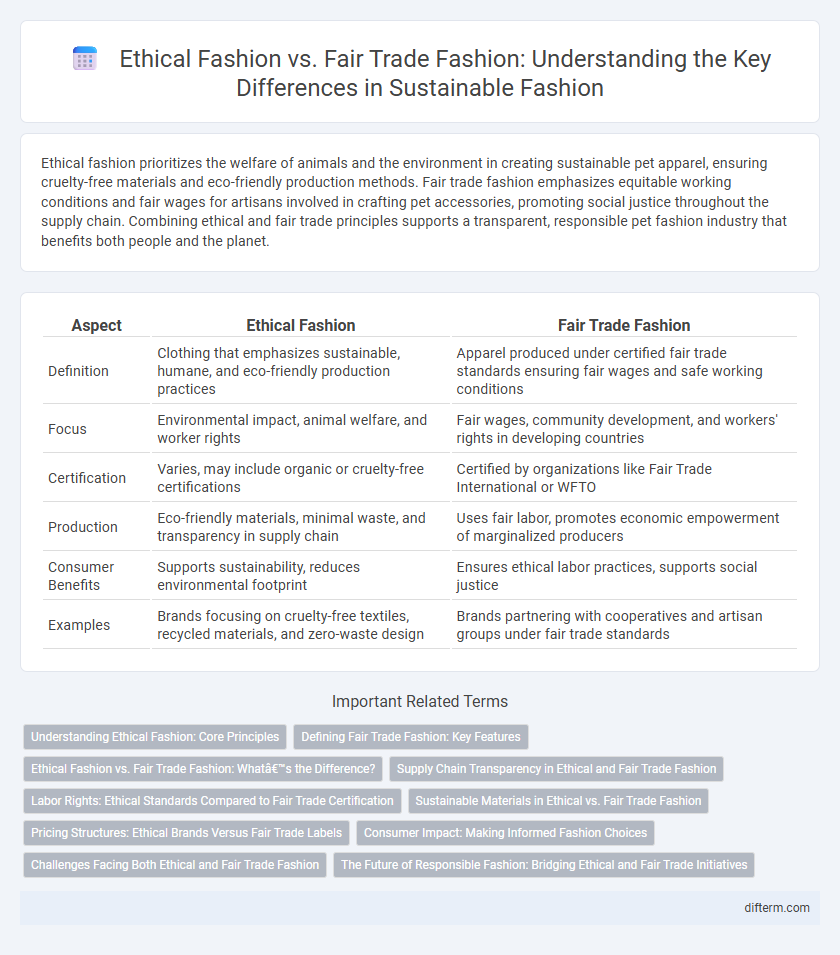Ethical fashion prioritizes the welfare of animals and the environment in creating sustainable pet apparel, ensuring cruelty-free materials and eco-friendly production methods. Fair trade fashion emphasizes equitable working conditions and fair wages for artisans involved in crafting pet accessories, promoting social justice throughout the supply chain. Combining ethical and fair trade principles supports a transparent, responsible pet fashion industry that benefits both people and the planet.
Table of Comparison
| Aspect | Ethical Fashion | Fair Trade Fashion |
|---|---|---|
| Definition | Clothing that emphasizes sustainable, humane, and eco-friendly production practices | Apparel produced under certified fair trade standards ensuring fair wages and safe working conditions |
| Focus | Environmental impact, animal welfare, and worker rights | Fair wages, community development, and workers' rights in developing countries |
| Certification | Varies, may include organic or cruelty-free certifications | Certified by organizations like Fair Trade International or WFTO |
| Production | Eco-friendly materials, minimal waste, and transparency in supply chain | Uses fair labor, promotes economic empowerment of marginalized producers |
| Consumer Benefits | Supports sustainability, reduces environmental footprint | Ensures ethical labor practices, supports social justice |
| Examples | Brands focusing on cruelty-free textiles, recycled materials, and zero-waste design | Brands partnering with cooperatives and artisan groups under fair trade standards |
Understanding Ethical Fashion: Core Principles
Ethical fashion emphasizes transparency, sustainability, and social responsibility throughout the supply chain, prioritizing humane working conditions and environmental stewardship. Core principles include reducing carbon footprints, using eco-friendly materials, and ensuring fair labor practices that protect workers' rights and well-being. This approach encompasses but extends beyond fair trade fashion, which specifically targets equitable trade terms and direct support for marginalized producers.
Defining Fair Trade Fashion: Key Features
Fair trade fashion emphasizes ethical production by ensuring fair wages, safe working conditions, and environmental sustainability throughout the supply chain. Key features include transparent sourcing, direct relationships with artisan communities, and adherence to strict certification standards such as Fair Trade Certified or WFTO. This approach promotes social equity and reduces exploitation, distinguishing it from broader ethical fashion practices that may vary in scope and certification.
Ethical Fashion vs. Fair Trade Fashion: What’s the Difference?
Ethical fashion emphasizes responsible production practices prioritizing environmental sustainability, animal welfare, and social equity, while fair trade fashion specifically focuses on ensuring fair wages and safe working conditions for artisans and farmers in developing countries. Both movements advocate for transparency and improved labor standards, but fair trade certification provides verified guarantees about equitable trade relationships. Understanding these distinctions helps consumers make informed choices aligned with their values regarding social justice and ecological impact.
Supply Chain Transparency in Ethical and Fair Trade Fashion
Supply chain transparency in ethical fashion involves detailed disclosure of sourcing, manufacturing conditions, and environmental impact to ensure responsible practices throughout the production process. Fair trade fashion emphasizes transparent supply chains as a core principle, guaranteeing fair wages, safe working conditions, and community empowerment for artisans and farmers. Both approaches prioritize traceability but fair trade specifically certifies compliance with social and economic standards to support marginalized producers globally.
Labor Rights: Ethical Standards Compared to Fair Trade Certification
Ethical fashion emphasizes comprehensive labor rights, including safe working conditions, fair wages, and the elimination of exploitative practices across the supply chain. Fair trade certification specifically guarantees that producers receive equitable pay and work in environments adhering to stringent social and environmental criteria. While both prioritize labor rights, fair trade provides a verifiable certification that ensures transparency and accountability in ethical sourcing.
Sustainable Materials in Ethical vs. Fair Trade Fashion
Ethical fashion prioritizes sustainable materials such as organic cotton, bamboo, and recycled fabrics to reduce environmental impact and promote responsible production. Fair trade fashion emphasizes sourcing these sustainable materials from certified producers who receive fair wages and work in safe conditions, ensuring social equity. Both approaches support the use of eco-friendly fibers but differ by balancing environmental goals with social justice standards.
Pricing Structures: Ethical Brands Versus Fair Trade Labels
Ethical fashion brands often implement transparent pricing structures that reflect sustainability and labor standards but may vary widely based on brand values and sourcing methods. Fair trade labels guarantee minimum pricing to producers, ensuring equitable pay and stable income, which can lead to higher retail costs but supports community development. The disparity in pricing between ethical fashion and fair trade products stems from their distinct certification processes and the degree of social responsibility embedded in the supply chain.
Consumer Impact: Making Informed Fashion Choices
Ethical fashion emphasizes sustainable materials and humane labor practices, while fair trade fashion guarantees fair wages and safe working conditions for artisans. Consumers who prioritize ethical or fair trade fashion contribute to reducing environmental harm and supporting social justice in the global supply chain. Making informed fashion choices involves researching brand transparency, certification labels, and the overall impact on communities and ecosystems.
Challenges Facing Both Ethical and Fair Trade Fashion
Ethical fashion faces challenges like supply chain transparency, high production costs, and limited consumer awareness, which hinder its scalability in competitive markets. Fair trade fashion struggles with ensuring fair wages and safe working conditions while maintaining affordability and meeting global demand. Both models grapple with balancing sustainability goals against economic pressures and complex international trade regulations.
The Future of Responsible Fashion: Bridging Ethical and Fair Trade Initiatives
Ethical fashion emphasizes transparent supply chains and sustainable materials to reduce environmental impact, while fair trade fashion prioritizes equitable wages and safe working conditions for artisans and farmers. Bridging these initiatives requires integrating strict labor standards with eco-friendly production practices to create a holistic approach to responsible fashion. The future of responsible fashion hinges on consumer demand driving brands to adopt both ethical sourcing and fair trade certification, fostering a more sustainable and just industry.
ethical fashion vs fair trade fashion Infographic

 difterm.com
difterm.com